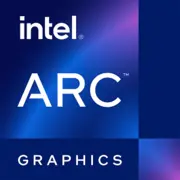Intel Arc A380

Intel Arc A380: Budget GPU with Ambitions
April 2025
Architecture and Key Features
Xe-HPG: The Foundation for a New Player
The Intel Arc A380 graphics card is built on the Xe-HPG architecture, designed for a balance between performance and energy efficiency. The manufacturing process is 6 nm (TSMC), which helps reduce heat generation and increase core frequencies. The base GPU frequency is 2000 MHz, with a peak of up to 2450 MHz.
Unique Features
- XeSS (Xe Super Sampling): Similar to NVIDIA's DLSS, it uses AI for image scaling while maintaining detail. In games like Cyberpunk 2077, XeSS boosts FPS by 30–40% in "Performance" mode.
- Hardware Ray Tracing: RT accelerator blocks provide support for global illumination and reflections effects, but their power is limited (performance is lower than NVIDIA RTX 3050).
- Support for Standards: DirectX 12 Ultimate, Vulkan 1.3, OpenGL 4.6, and AMD FidelityFX CAS (Contrast Adaptive Sharpening) technology.
Memory: Speed and Size
GDDR6 and 96-bit Bus
The Arc A380 is equipped with 6 GB of GDDR6 memory with an effective speed of 15.5 Gbps. The bus width is 96 bits, resulting in a bandwidth of 186 GB/s. For comparison, the NVIDIA RTX 3050 (128 bits) has a bandwidth of 224 GB/s.
Impact on Performance
The memory size is sufficient for gaming at 1080p on high settings, but in 1440p there may be stutters due to a lack of VRAM in projects with HD textures (e.g., Horizon Forbidden West). The bandwidth limits the rendering speed of complex scenes, making the card less suitable for 4K gaming.
Gaming Performance
1080p: Comfortable Gaming
- Apex Legends (high settings): 75–90 FPS.
- Elden Ring (medium settings + XeSS): 60 FPS.
- Cyberpunk 2077 (medium settings, ray tracing off): 45–55 FPS. With RT enabled, it drops to 25–30 FPS, but activating XeSS boosts it back up to 40 FPS.
1440p and 4K: Not for Everyone
In Fortnite (Epic settings, 1440p): 35–45 FPS. To achieve smooth gaming, you need to reduce quality or use XeSS. 4K remains impractical — even in CS2, the average FPS does not exceed 60.
Professional Tasks
Editing and Rendering
The card shows modest results in software like Adobe Premiere Pro and Blender. In PugetBench tests for Premiere Pro, it scores 450 points compared to 600 for the NVIDIA RTX 3050. Support for AV1 encoding is a plus for streamers looking to save bandwidth.
Scientific Calculations
OpenCL performance is sufficient for basic tasks (data processing in MATLAB), but NVIDIA's CUDA cores remain unmatched. For serious computations, it is better to consider models with a larger number of cores.
Power Consumption and Heat Dissipation
TDP 75 W: Energy Efficiency
The A380 does not require additional power — the PCIe x16 slot is sufficient. This makes it ideal for compact builds. Average power consumption in games is 60–70 W.
Cooling and Cases
The reference models come equipped with a heatsink and a single fan. Under load, temperatures reach 70–75°C. For better cooling, it is recommended to use a case with 2–3 fans (e.g., Fractal Design Meshify C).
Comparison with Competitors
NVIDIA GeForce RTX 3050 (6 GB)
- Price: $180 vs. $130 for the A380.
- The RTX 3050 is 15–20% faster in games, but does not support AV1 encoding.
AMD Radeon RX 6400
- Price: $120.
- The RX 6400 is weaker in ray tracing and lacks a counterpart to XeSS but consumes only 53 W.
Conclusion: The A380 is a compromise for those looking for new technologies on a budget.
Practical Tips
- Power Supply: A 400 W PSU is sufficient (e.g., be quiet! System Power 10).
- Compatibility: Requires PCIe 4.0 x16 and a motherboard with UEFI (check for BIOS updates).
- Drivers: By 2025, Intel has fixed most issues, but keep software updated through Intel Driver & Support Assistant.
Pros and Cons
Pros:
- Low price ($130–150).
- Support for AV1 and XeSS.
- Energy efficiency.
Cons:
- Weak RT performance.
- Only 6 GB of memory.
- Limited optimization in older games.
Final Verdict
The Intel Arc A380 is a solid choice for:
1. Budget Gamers willing to compromise on AAA titles.
2. Streamers who value AV1 encoding.
3. Office PCs with the ability to run light games.
If you’re looking for maximum FPS for $150, consider the AMD RX 6400. But for an introduction to ray tracing and modern technologies, the A380 is the best option in its class.
Basic
Memory Specifications
Theoretical Performance
Miscellaneous
Benchmarks
Compared to Other GPU
Share in social media
Or Link To Us
<a href="https://cputronic.com/en/gpu/intel-arc-a380" target="_blank">Intel Arc A380</a>